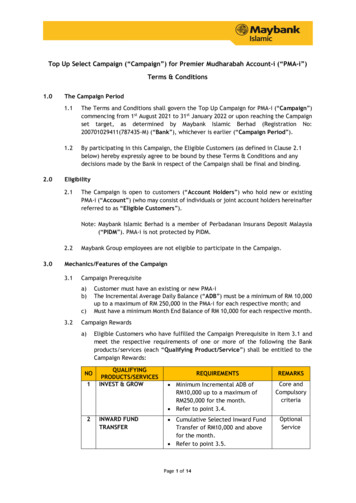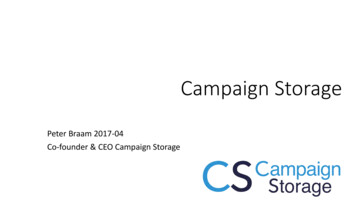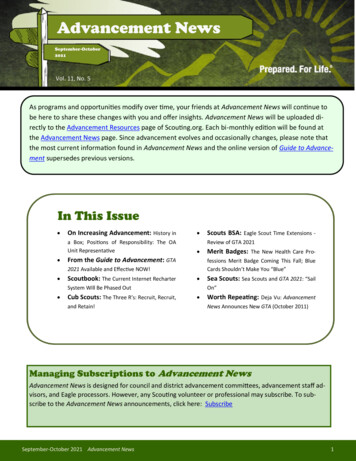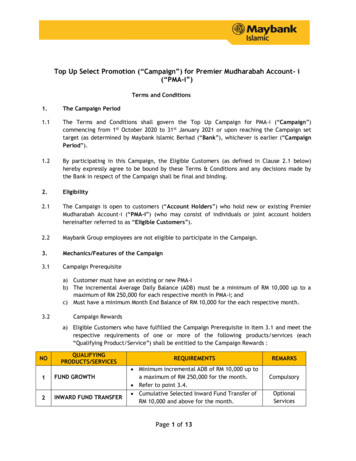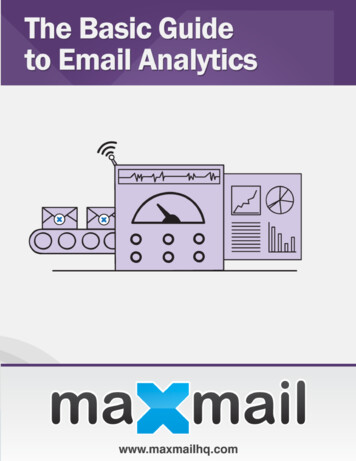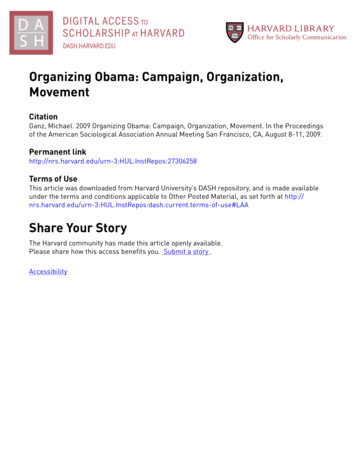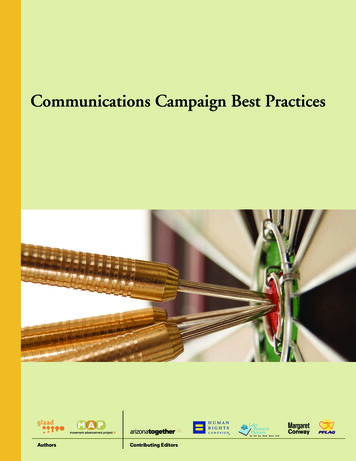
Transcription
Communications Campaign Best PracticesAuthorsContributing Editors
January 2008, Gay & Lesbian Alliance Against Defamation(GLAAD) and the Movement Advancement Project (MAP).All rights reserved.
Introduction3Effective Communications Campaigns3Elements of an Effective Communications Campaign3Setting a Campaign ObjectiveThree Things to Consider When Setting Campaign ObjectivesTarget Audience337This Campaign Isn’t About You7The General Public Isn’t a Target Audience7Five Ways to Narrow Your Target Audience7Messaging and Creative Development9If You Can’t Test It, Don’t Run It9Messaging and Creative Should Be Based on Research9Six Steps to Effective Messaging and Creative9Stay on Message!Market Research Overview1113Why You Should Understand Market Research13Hiring a Good Market Research or Political Polling Firm13Market Research Basics14Qualitative Market Research17In-Depth Interviews17Focus Groups17Five Deadly Focus Group Mistakes18Elicitation Techniques19A Note about Online Research19Limitations of Qualitative Research19Quantitative Market Research21Sample Selection21Survey Design22Question Sequencing23Question Scales24Clear, Unbiased Questions24Split Samples25Interpreting Results25Survey Types26Integrating Qualitative and Quantitative Research26Creative Testing291Communications Campaign Best PracticesCommunications CampaignBest Practices
Communications Campaign Best Practices2Basic Creative Testing29What to Test30Limitations30Media Planning31Creating a Media Plan31Buying Media32Post-Buy Analysis (Did You Get Your Money’s Worth?)32Analysis of Other Media Purchases35Getting Media Coverage37Proactive Pitches37Building Relationships with Reporters37Creating the Contact List38Know the News Cycle39Not All Coverage Is Good Coverage39Press Releases41Press Release Format41What Makes a Press Release Good?42Submitting a Press Release42Op-Eds and Letters to the Editor42Interviewing Like a Pro43Know What You’re Going to Say43Practice Saying It43Say It43Integrating Acts of Protest47Effective Spokespeople51Setting a Budget53Six Ways to Stretch Your BudgetCampaign Evaluation5355Evaluation Principles55Typical Evaluations56Evaluation Methodology56A Word on the Challenges of Evaluation57Communications Campaign Plan Template58
3IntroductionIf we asked you to name three advertising campaignsthat fundamentally changed America, you’d probablyneed some time to think. But what if we asked you toname three ideas that changed America? You mightmention “the war on terror,” “gun safety,” “liberalmedia bias,” or “global warming.” Or, you might rattleoff some of the biggies—all men are created equal, forexample, or freedom of speech.The point is this: It’s not about your campaign. It’sabout shaping the way America talks about yourissues. Fundamental change in America requires along-term battle over ideas, not just clever billboards.The political right knows that it’s easier to sell “exploration for energy” than to talk about “drilling in naturepreserves.” Whoever defines the issues in a way thatmobilizes public support wins the debate.That’s why effective communication campaignsrequire planning and homework. The Art and Scienceof Framing an Issue explains how to define your issueto create public support.However, framing is only part of the solution. Youalso need to communicate your message. How areyou going to talk about your issue? Who’s going tosay it? To what target audience? Through what media,on what budget, and to accomplish what goals?Communications Campaign Best Practices bringstogether everything you need, from informationon setting a campaign objective to measuring yourcampaign’s results—and everything in between.Together, these two documents will help you defineyour issue and effectively get your message out—andultimately, help shape how Americans understandLGBT people and equality.Ideas that are changingAmerica: Gun safetySetting a Campaign ObjectiveBefore launching a campaign, get agreement on whatyou’re trying to accomplish. This may seem obvious,but it’s quite common for the campaign objective tobe assumed rather than spelled out—and assumptions can lead to trouble. If you expect the campaignto get people to stop and think, but your executivedirector expects it to stop traffic, you have a problem.All parties involved in the campaign need to agree tothe objectives up front. That way, when the ad agencypresents a traffic-stopping ad that won’t change publicopinion, you can confidently send it back to the drawing board. Having an up-front agreement on objectivessets the tone for the entire campaign and influences alldecisions going forward.Four Things to Consider When SettingCampaign ObjectivesYou should answer four major questions when settingyour campaign objectives:1. What’s the goal of the campaign? Be veryElements of an Effective CommunicationsCampaignWhether you hire a professional agency to promoteyour issue, or execute an in-house campaign on ashoestring budget, it’s helpful to understandwhat makes a campaign succeed. The charton the following page summarizes the majorelements of an effective communicationscampaign. Turn to the corresponding sectionfor a more complete description of eachcampaign element.clear about what you want the campaign to do.Should it educate the public about an issue?Change behavior? Win a short-term politicalfight? What you’re trying to do directly affectshow you’ll do it.If your campaign is about passing legislation, gettingvotes, or fighting a ballot initiative, you may need toforgo messages that are personally important to you andinstead use messages that move the public.Communications Campaign Best PracticesEffective Communications Campaigns
4Communications Campaign Best PracticesElements of an Effective Communications CampaignIf You Only Remember OneThing, Remember ThisCorrespondingFact Sheet(s)Campaign ElementThe Question YouNeed to Answer1. Campaignobjective or goal(clearly statedand agreed to byall parties)What are youA good campaign requires focus. Iftrying to accomplish? you try to do too much, you won’tdo anything well. Setting a Campaign2. Targetaudience(s)Who are youtrying to reach?“The general public” is not atarget audience. If you try to reacheveryone, you’ll end up reaching noone. Target Audience (pg. 7)3. Messages andresearchWhat are yougoing to say toyour audience sothey’ll take notice,listen, and hopefullybecome supportive?What resonates for you and yourbase often doesn’t work for yourtarget audience. The differencebetween messaging that you likeand messaging that is effective canbe huge. It generally takes researchto know the difference. Messaging and CreativeObjective (pg. 3)Development (pg. 9) Marketing ResearchOverview (pg. 13) Qualitative Research (pg. 17) Quantitative Research (pg.21) Creative Testing (pg. 29)4. MediacommunicationsplanHow are you goingto reach youraudience?People generally need threeexposures to a message beforethey hear it. Your media planshould reach the same peoplemultiple times. Don’t spread mediaplacements too thin. Media Planning (pg. 31) Getting Media Coverage (pg.37) Press Releases (pg. 41) Integrating Acts of Protest(pg. 47)5. Messengers orspokespeople(clearlyidentified)Who’s going to sayit?The best spokesperson may not beyour executive director, your staff,or even your constituents. There’soften a big difference between whoyou like and trust, and who yourtarget audience likes and trusts. Effective Spokespeople (pg.6. Budget (withadequateresources)How much moneydo you have to makeit happen?If you don’t have enough money tolaunch an effective campaign that’sbased on research, you’re better offnot doing it. If you have a limitedbudget, look at slimming downyour target audience, reducing paidplacements, or increasing emphasison earned media. Setting a Budget (pg. 53)7. CampaignevaluationHow will you knowwhat worked andwhat didn’t?Investing in campaign evaluationis worthwhile. It helps you gaincredibility with funders and ensuresthat money is well spent in thefuture. Campaign Evaluation (pg. 55)51)
52. Do you want to change public opinion, orImagine you care about global warming andyour dad is debating between a Hummer anda Prius. Your dad doesn’t give a flip about theenvironment, but he does worry about hispocketbook. While you want to use argumentsthat make him care about the Earth, he’ll buythe Prius if you explain how much he’ll save ingas and on the purchase price.In other words, what you want to communicate(e.g., the justness of your cause) and whatactually helps to change minds, behaviors, andvotes, may be two entirely different things. Ifyour objective is to win on an issue, you needto use messages that research shows actuallymoves public opinion on the issue. Do youactually want to protect LGBT families or doyou want to talk about protecting LGBT families? If your campaign is about passing legislation, getting votes, or fighting a ballot initiative,you may need to forgo messages that arepersonally important to you and instead usemessages that move the public.3. Is the campaign short- or long-term? Thelength of your campaign affects the approachyou can take. Short-term campaigns don’thave time to educate; they must move peoplequickly. Alternatively, long-term campaigns canfocus on educating the public and changingopinions over time—sometimes just by building familiarity. Research shows, for example,that images of two gay men with a childcreates significant negative backlash. While wewouldn’t recommend using this imagery tofight a short-term adoption initiative, it couldbe appropriate as part of a long-term publiceducation campaign about LGBT families. Keepin mind, however, that long-term campaignsrequire careful staging to build acceptanceover time. If the campaign uses increasinglyedgy images or phrasing, make sure you haveenough exposure of each ad in the series thatpeople can follow the progression and warmTip: Try to get the buy-in of all key stakeholders,including other LGBT groups potentially affectedby the campaign.In the early stages of campaign planning, ArizonaTogether held a Town Hall to discuss how to fightan upcoming Super DOMA ballot initiative (i.e., aconstitutional ammendment to ban both marriageand civil unions/domestic partnerships for gaycouples). The several hundred advocates in attendance agreed that the goal of the campaign shouldbe to successfully fight the initiative, not to educatethe public on LGBT issues or promote messages torally the base. This upfront agreement on objectiveskept the campaign on track when message testing resulted in an emphasis on straight domesticpartners—as opposed to the traditional focus onsame-gender couples preferred by most advocates.Tip: Messaging to win may mean using messagesoutside your established comfort zone.One environmental group prevented an airportexpansion by talking about noise pollution insteadof wetlands protection, even though wetlandsprotection was the issue they personally caredabout. Similarly, the television commercial thattested best (and was eventually aired) in the ArizonaTogether campaign featured straight couples, notgay or lesbian couples. It may have felt uncomfortable to focus on straight couples, but it paid off onElection Day when Arizona Together became thefirst campaign ever to defeat an anti-gay marriageballot initiative.Communications Campaign Best Practicescommunicate messages that are important toyou? They’re often two different things. Socialjustice advocates sweat, bleed, and forgo theirchance to make millions in corporate Americabecause they care deeply about their issue.Advocates often want others to not only stopopposing them, but also to understand thattheir issue is right and just.
6Communications Campaign Best PracticesResponding to a Ballot Initiative (or Similar Situation)We’d like to acknowledge how hard it can be to choose between running a winning campaign andrunning a campaign that says what you want to say. Perhaps you’ve been running on a shoestringbudget for years. Suddenly, your state is facing a ballot initiative (or similar measure) and the spotlight is on you. You have funding at levels you’ve never seen before. It feels like your chance to finallyget your message across. You don’t want to talk about how the Super DOMA will hurt heterosexualsenior citizens, you want to talk about LGBT families. It’s a natural feeling, but it’s also a good wayto lose your fight.The good news is that messaging to win the short-term battle can also be one of the best ways toincrease long-term support. If you can change public opinion on a major issue that affects LGBTpeople, you’ll also shift overall attitudes toward LGBT people. A successful campaign also attractsfuture donors. Most importantly, you’ll have helped enact important legal protections or defeatproposed legislation that would cause significant harm to the LGBT community.Messaging to win also takes conviction and leadership. It requires you to clearly define what you’retrying to accomplish and be direct about what you’re giving up. It means building support andeducating others about your campaign message, and disciplined focus amid criticism from thosewho want to communicate a different message. It means running the campaign from your head, not yourheart.In 2005, Arizona Together decided it had a chance to defeat the 2006 Super DOMA if it did threethings. First, hire a professional firm to help run the campaign. Second, ask the firm to conductresearch. Third, ruthlessly follow the firm’s advice based on the research. Some advocates opposedthe campaign’s resulting focus on straight couples, arguing it would do nothing to further long-termsupport for LGBT equality. However, highlighting straight couples helped the target audience relate.Once Arizonans saw how the Super DOMA hurt “couples like them,” it was easier to empathize withsame-gender couples in similar situations.gradually to the ideas and creative concepts.Also make sure that the campaign movesslowly enough that people have time to adjust.Unfortunately, very few non-profits have the resources to stage effective long-term campaigns.4. How can the campaign help us build a strongercommunity? Campaigns aimed at the moveable middle generally won’t use messages thatenergize your constituents and supporters.However, these campaigns still present an excellent opportunity to strengthen your organization,membership base and allies. Use the campaignas a reason to reach out. Help others understandwhat you’re doing and why.Instead of changing your messages, rally thecommunity by holding educational and discussion forums; organizing canvassing efforts thatmobilize volunteers and voters; engaging alliessuch as local clergy, business leaders, andvolunteers; etc. Capacity building and field workplays a vital role in ensuring your local community or state comes out of a campaign strongerthan it was before. Messaging and communications discipline don’t mean these goals aren’timportant—it simply means that communications to the moveable middle are separate fromcommunications and strategies for working withyour base.
7Target AudienceUnless the campaign goal is to fundraise or mobilizethe base, your target audience will likely consist ofpeople who are on the fence or mildly unsupportiveof your issue. The campaign needs to be about them,using imagery and messages that appeal to them,with ad placements in media that they read, watch,or listen to.What works for you and what works for your targetaudience are likely two different things. You maywant your dad to understand that Hummers arean environmental travesty. However, if he simplyrolls his eyes and continues on to the dealership,then you’ve encountered a typical mistake in communications campaigns. If your dad primarily caresabout his pocketbook, are you prepared to forgoyour environmental argument and talk about howmuch the Hummer will cost him? Would you ratherbe right, or would you rather prevent your dad frombuying a Hummer?The General Public Isn’t a Target AudienceChances are you have a limited budget. This meansyou can’t reach everyone, since the more peopleyou try to reach, the more money it costs. Decadesof marketing research shows that unless a messagereaches an audience three or more times, the messagegoes unheard. That means you have to focus yourcampaign if you want to avoid the drop in the oceaneffect. The question remains: How do you narrow yourtarget audience?Five Ways to Narrow Your Target AudienceYou can narrow your target audience using age,ethnicity, gender, geography, political or religiousviews, current level of support for LGBT issues, andso forth. Whatever criteria you use to narrow youraudience, consider the following five things:1. Which audience best helps you meet yourspecific campaign objectives? Your campaignobjectives will determine the target audience.For example, if you want to mobilize the base,only reach out to people who are already supportive. (If someone isn’t sure they even supportyour cause, they sure as heck won’t rally for it!)“Before taking the Arizona Together television adpublic, we showed it to a few donors. They hatedit. I said, ‘Good, I hate it too. If we all hate it, it’sprobably pretty effective.’”—Representative Kyrsten Sinema, Arizona Houseof Representatives, former Chair of the ArizonaTogether campaignThe most creative ad campaign in the world isn’tgoing to get a member of Hell’s Angels to roll intoa biker bar wearing a pastel-colored polo shirt.Similarly, some people will never embrace LGBTissues, no matter how good your campaign.On the flip side, if you want to grow your base,reach out to fence-sitters and the moveablemiddle.2. Is this audience persuadable? The most creativead campaign in the world isn’t going to get amember of Hell’s Angels to roll into a biker barwearing a pastel-colored polo shirt. Similarly,some people will never embrace LGBT issues,no matter how good your campaign. If youtarget the extreme right, recipients will likelyshred your mailer without ever reading it—andyou’ll have wasted postage and killed a tree.Conversely, a strong supporter may feel greatafter getting your mailer, but you haven’t movedanyone who was undecided. We generallyrecommend you target the moveable middle,that is, those who don’t currently support yourissue, but may be persuaded given the rightmessaging. The moveable middle is also referredto as the “mushy middle,” “greys,” and “independents.” It includes: People with moderate political views (abouttwo-thirds of the moveable middle) People aged 35 to 55 (about two-thirds of themoveable middle; youth are generally supportive while older Americans tend to opposeLGBT issues) Women (about two-thirds of the moveablemiddle)Communications Campaign Best PracticesThis Campaign Isn’t About You
8Communications Campaign Best PracticesTip: Before you do any form of public communications, clarify your target audience. Do you want toreach the base or the moveable middle? Remember,communications to member lists won’t get you newsupporters. Preaching to the choir might feel good,but they’re already singing your tune. Unless you’retrying to mobilize the base, your money’s betterspent reaching out to the moveable middle. Hispanic audiences (tend to be fairly supportive of LGBT issues, but may be less supportive on marriage) Democrats or unaffiliated (fewer areRepublican) Suburban dwellersNote that you may need to do a local poll tobetter define this segment for your particularstate or region.3. Which segment has the most influence andimpact? Even after you define the best targetaudience to support your issue, you may stillfind it’s too large for your budget. If you face thispredicament, think of easy ways to furthernarrow the scope. For example, eliminate thosewho aren’t registered to vote (unless, of course,the campaign is a get-out-the-vote effort). Ata more nuanced level, consider focusing thecampaign on opinion leaders and influencers,such as community leaders, business leaders,or progressive clergy who can “bring others withthem” if you win their support.4. Can you realistically reach the target audience?Define your target audience in a way that allowsyou to actually reach them. While some marketresearch firms like to break the target audiencedown into psycho graphic segments, we generally don’t recommend this unless you’re willingto spend a lot of time and money figuring outhow to reach and track them. While it may beinteresting to know there’s a target audiencesegment called “shapers” who like to set trendson public issues, this information isn’t alwayspractical. For a campaign to be successful, youneed to actually reach your target audience ascost-effectively as possible—and that meansunderstanding their demographics and mediaconsumption patterns. If you want to reach30-year-old men, you might consider an ad in acar magazine, while to reach college-age women,you might run an ad in Cosmopolitan. It’s muchmore difficult, expensive, and time-consumingto figure out how to reach members of a psychographic segment.5. Have you applied a ruthless focus? “No man leftbehind” does not apply to your target audience.Your target audience should be large enough tomake a difference, but small enough that youcan influence them. By definition, when youfocus on one audience, you ignore another. Thisis good—corporations do it all the time. You maypersonally love the new iPod shuffle, but if yourgrandmother doesn’t own a computer and thinksrocking out is a gardening term, she won’t givea hooey that the iPod comes in five differentcolors. The point is that Apple doesn’t expect(or even want) its ad campaign to resonate withGrandma. They’re willing to sacrifice Grandmato reach 20-something urban hipsters. Reachingone audience effectively means not reachinganother.What creates added pressure for social advocacygroups is that to grow the base, you need tospeak to those outside the base. Messages thateffectively sway moveable middle voters likelywon’t resonate with your supporters. In fact, ifyour base can’t relate to your campaign messages, it means you may have it right. That said,we recommend you spend some time helpingyour supporters understand the reasoningbehind your communications approaches. Thatway, they’ll understand why the messages don’tresonate with them—and be more invested inthe campaign’s success.
9We can’t overstate this (though we’re getting awfullyclose)! Messages need to reach and convince yourtarget audience, not your executive director, yourfavorite donor, the chair of your board, or your moststrident opponent. You need to reach your targetaudience where they’re at, and appeal to their deeplyheld values, using language they can relate to (seeThe Art and Science of Framing an Issue).Messages need to reach and convince your targetaudience, not your executive director, your favoritedonor, the chair of your board, or your moststrident opponent.“Those campaigns in which the group has predetermined a message are usually doomed to failure.”—Foundation Center, 2004.If You Can’t Test It, Don’t Run ItNon-profits often argue that they can’t afford to testtheir messages. We argue that they can’t afford notto. It’s like buying a car and forgoing insurance. If youhave the money to run a campaign, spend the moneyto ensure it’ll be effective. If your budget is thinnerthan single-ply toilet paper, even a quick-and-dirty testis better than nothing. If you have to, run your ad byyour brother-in-law (not the one who loves you, butthe one who looks a little nervous whenever you dropby). Alternatively, knock on the doors of a few neighbors, or show your creative to random strangers at thelocal shopping mall. Even these basic techniques canhelp you identify red flags and fine-tune your message. See “Creative Testing” for more information onhow to do this.Messaging and Creative Should Be Based onResearchWe’re not fans of the Martha Stewart Living magazine.And we’d rather have a root canal then spend ourholidays weaving homemade wreaths from commonhousehold scraps. But Martha Stewart loyalists wouldcancel their subscriptions in droves if the magazinesuddenly started looking like Harpers, one of ourfavorites. Why? Because we just stopped speaking thelanguage Martha’s fans care about.If you’re talking to people who aren’t like you, you’llbe more effective in reaching them if you can speaktheir language. You believe in your cause, but as partof your campaign, you’ll be talking to people whodon’t (yet) believe in it. Put simply, you’ll be talkingto people who don’t think like you do.No matter how well you believe you know yourtarget audience, the reality is that they know themselves better. That’s why campaign messages basedon research are invariably more successful thanthose developed by intuition. Your intuition may bereliable when it comes to you, but it’s less reliablewhen it comes to someone else. Effective messagingrequires that you: Research how the target audience thinks and why Devise messages based on the research Test the messages to ensure they workSix Steps to Effective Messaging and Creative1. Use qualitative research to understand thetarget audience. At the preliminary stage ofmessage development, it’s more important tounderstand how people think than to understandtheir level of support for your issue. How dothey talk about your issue? What metaphorsand patterns of reasoning do they use? Whatconnections do they form to other issues? Whatlanguage or words trigger defensive reactions?Clues may come from what’s omitted and moments of inconsistency.Note that learning how people think about yourissue requires qualitative, not quantitative,research. While polls help you understand levelsof support, pinpoint your target audience, andidentify reactions to specific messages, pollsTip: Start by reviewing existing market and opinionresearch. You can learn a lot by watching thefocus group videos or reviewing the polling dataof like-minded organizations. Supplement existingresearch with your own focus groups, or, if you can’tafford those, conduct some one-on-one interviews.This will help you gear the research to your particular issue, target audience, or geography.Communications Campaign Best PracticesMessaging and CreativeDevelopment
Communications Campaign Best Practices10won’t help you understand the subtleties of whatyour target audience believes, why they believeit, and how they talk about it.2. Develop messages for testing. Based on yourresearch, develop messages for testing. This isyour time to experiment. Don’t test five variations of a similar message; instead, developdifferent messages and see what works. Forexample, let’s say you want to convince othersto care about global warming. One approachmight ask people to take responsibility for theworld they leave their grandchildren. Anotherapproach might showcase the consequences ofglobal warming on the natural world. Appealingto posterity is a very different approach thanshowing photos of melting ice caps and starvingpolar bears. Once you determine which approachis more effective, you can start to fine-tune thespecific language, imagery and delivery of yourmessage.Some questions to ask when drafting a messageare: What are you asking people to do, think, orfeel as a result of the campaign? Does the message appeal to the deeply heldvalues of the target audience without triggering an opposing frame? Is the message appropriate, given the education, perspective, and values held by yourtarget audience?Six Steps to EffectiveMessaging and Creative1. Use qualitative research to understand the targetaudience2. Develop messages for testing3. Test the messages4. Refine the messages and develop the creative5. Test the creative (qualitatively)6. Refine and finalize Are the messages based on what you knowabout the opinions of your target audience? How will your messages stand up to confrontation and criticism?3. Test the messages. Effective messaging isn’tabout wanting to say something and then justsimply saying it; it’s about knowing what youwant your messages to do (e.g., get people tovote a certain way), and then figuring out whatyou need to say to make that happen. This takesresearch, not intuition. The only way to know ifyour messages will do what you need them to dois to test them.You can test your messages qualitatively orquantitatively. While qualitative message testinggives you insight into how people respond toyour messages and why, it doesn’t give you anyassurance that your broader target audience willrespond in the same way. If you want quantitative data (i.e., data that’s statistically valid) youcan use polling to test different wording andhave respondents rate whether or not it’s compelling. For more information see QualitativeResearch and Quantitative Research in thistoolkit.4. Refine the messages and develop the creative.Use your message testing results to developyour final messages. Now it’s a matter of finetuning and creative execution. At this stage, youknow what you’re going to say. Now it’s a matterof how exactly you’ll say it. In an ideal world,you’d develop different versions of the creativeand do one last round of testing.5. Test the creative (qualitatively). Before finalizingthe creative, test the complete package, includingimagery, text, headlines, etc. The creative testingcan take different forms depending on your budget. You can test storyboards, mock-ups, or even“finished” ads (see Creative Testing). If you havean adequate budget, start by testing differentad concepts. Then, refine the winning conceptto understand how changing certain elementswill impact the ad’s effectiveness. For example,two ads with the same copy and layout, but withdifferent background imagery, could impact thesame audience totally differently. Look to understand how people respond to different headlines,words, and images. Again, use the brother-in-lawtest if you don’t have a budget for anything else.
11Stay on Message!Once you’ve figured out you
Communications Campaign Best Practices. brings together everything you need, from information on setting a campaign objective to measuring your campaign's results—and everything in between. Together, these two documents will help you define . your issue and effectively get your message out—and ultimately, help shape how Americans understand
